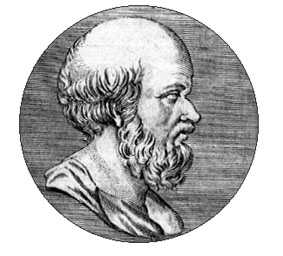Robin Lane Fox
Hecatæus of Miletus
Hecatæus of Miletus (c. 550-476 BC) was one of the earliest Greek geographers. His view of the ‘world’ was that the then current concept of a landmass with the Mediterranean at its centre, encompassed by Europe and parts of Africa and Asia, all of which are surrounded by the Great Ocean or Okeanos. What is interesting about this model is that it does not show any island opposite the Strait of Gibraltar or even a hint of a ‘continent’ opposite as described by Plato. It should be noted that Hecatæus lived after Solon and also visited the priests of Egypt. As he did not make provision on his map for Atlantis it would suggest that he was not given the story or if he was, he was too sceptical to record it. In fact Hecatæus was inclined to dismiss much of Greek mythology as ‘ridiculous’.
which are surrounded by the Great Ocean or Okeanos. What is interesting about this model is that it does not show any island opposite the Strait of Gibraltar or even a hint of a ‘continent’ opposite as described by Plato. It should be noted that Hecatæus lived after Solon and also visited the priests of Egypt. As he did not make provision on his map for Atlantis it would suggest that he was not given the story or if he was, he was too sceptical to record it. In fact Hecatæus was inclined to dismiss much of Greek mythology as ‘ridiculous’.
Robin Lane Fox, the English classicist, wrote that the Hecateus located the Pillars of Heracles at Gibraltar[1403.208].
It is of interest that during his visit to Egypt, Hecateus was shown 345 statues by the priests at Thebes that represented as many generations of high priests. It is thought that he was not impressed by this claim. However, this reference has been employed as evidence for the great antiquity of the Egyptians and as firm support for Plato’s date of 9600 BC for the war with Atlantis.
Also worth noting is the fact that many decades later when Herodotus was shown the same collection of statues along with a similar claim of antiquity, the number recorded had dropped to 341!
Peter James has pointed out [047.75] that in the ancient world it was commonplace for nations to claim the greatest antiquity for their homeland, with Egypt, Phrygia and Babylonia being prominent contenders.
Eratosthenes of Cyrene
Eratosthenes of Cyrene (c. 276–c. 194 BC) was a Greek geographer, astronomer and mathematician. Around 240 BC he was appointed librarian at the Great Library at Alexandria. He is sometimes credited with coining the term ‘geography’ to describe the study of the earth. He was somewhat unkindly nicknamed ‘Beta’ as he was considered to be second best in many subjects. Strabo (Bk II Chap 4.4) was quite critical of Eratosthenes. Nevertheless, Eratosthenes is the first person known to have calculated the Earth’s circumference and measured the tilt of the Earth’s axis and his work led to the most accurate maps and globes for a thousand years.
>However, Eratosthenes was not slow to offer criticism himself, being a persistent critic of Homer, whom he considered to be a fantasist. Strabo reported what the geographer had said in the late 3rd century BC: “You will find the scene of Odysseus’ wanderings when you find the cobbler who sewed up the bag of winds.”(b)<
Dhani Irwanto noted that “Eratosthenes was also the first geographer to parallels and meridians within his cartographic depictions, attesting to his understanding of the spherical nature of the earth.”(a)
 Eratosthenes unwittingly entered the Atlantis debate around 250 BC, when he was one of the first to unambiguously place the Pillars of Heracles at the Strait of Gibraltar, while many contend that prior to that the ‘Pillars’ were located at the Strait of Sicily or was, according to Servius, a term applied simultaneously to more than one location, indicating the limit of general maritime knowledge at any given period or as I am inclined to believe, the term had over time become just a metaphor, rather than a reference to a specific location! I consider it highly relevant that no writer prior to Eratosthenes had referred to the Pillars of Heracles being located at Gibraltar.>Given the scarcity of relevant information from Greek sources,<it is not unreasonable to conclude that this silence reflects the lack of knowledge possessed by the ancient Greeks regarding the western Mediterranean, which only improved gradually, as their colonising and trading expanded westward.
Eratosthenes unwittingly entered the Atlantis debate around 250 BC, when he was one of the first to unambiguously place the Pillars of Heracles at the Strait of Gibraltar, while many contend that prior to that the ‘Pillars’ were located at the Strait of Sicily or was, according to Servius, a term applied simultaneously to more than one location, indicating the limit of general maritime knowledge at any given period or as I am inclined to believe, the term had over time become just a metaphor, rather than a reference to a specific location! I consider it highly relevant that no writer prior to Eratosthenes had referred to the Pillars of Heracles being located at Gibraltar.>Given the scarcity of relevant information from Greek sources,<it is not unreasonable to conclude that this silence reflects the lack of knowledge possessed by the ancient Greeks regarding the western Mediterranean, which only improved gradually, as their colonising and trading expanded westward.
The noted English classicist, Robin Lane Fox, wrote in his Travelling Heroes that both Hecateus and Herodotus has located the ‘Pillars’ at Gibraltar[1403.208].
2010 saw the publication of the first English translation of Eratosthenes’ Geographika[761] by Duane W. Roller.
(a) https://atlantisjavasea.com/tag/eratosthenes/
(b) Strabo 1.2.15 *
